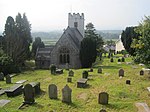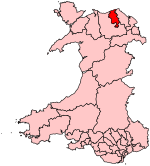Tremeirchion
Tremeirchion

Tremeirchion (previously known as Lleweni) is a small residential community in Denbighshire, Wales. It lies on the B5429 road, to the north east of Denbigh and to the east of St Asaph. The community includes the village of Rhuallt. The town was part of the traditional lands of the Salusbury family and the Cotton baronets. It was dominated by these two families until the early part of the 20th century. It briefly became well known during the fin de siècle after a series of dinosaur bones were found in the area.
Excerpt from the Wikipedia article Tremeirchion (License: CC BY-SA 3.0, Authors, Images).Tremeirchion
B5429,
Geographical coordinates (GPS) Address Nearby Places Show on map
Geographical coordinates (GPS)
| Latitude | Longitude |
|---|---|
| N 53.245 ° | E -3.377 ° |
Address
B5429
LL17 0UE , Tremeirchion
Wales, United Kingdom
Open on Google Maps









